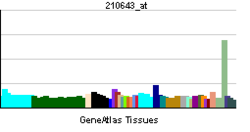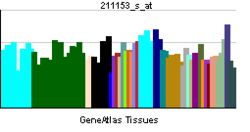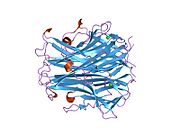- RANKL
-
Receptor activator of nuclear factor kappa-B ligand (RANKL), also known as tumor necrosis factor ligand superfamily member 11 (TNFSF11), TNF-related activation-induced cytokine (TRANCE), osteoprotegerin ligand (OPGL), and osteoclast differentiation factor (ODF), is a protein that in humans is encoded by the TNFSF11 gene.[1][2]
RANKL is important in bone metabolism. This natural and necessary surface-bound molecule (also known as CD254) found on osteoblasts serves to activate osteoclasts, which are the cells involved in bone resorption.
Function
RANKL is a member of the tumor necrosis factor (TNF) cytokine family which is a ligand for osteoprotegerin and functions as a key factor for osteoclast differentiation and activation. RANKL also has a function in the immune system, where it is expressed by T helper cells and is thought to be involved in dendritic cell maturation. This protein was shown to be a dendritic cell survival factor and is involved in the regulation of T cell-dependent immune response. T cell activation was reported to induce expression of this gene and lead to an increase of osteoclastogenesis and bone loss. This protein was shown to activate antiapoptotic kinase AKT/PKB through a signaling complex involving SRC kinase and tumor necrosis factor receptor-associated factor 6 (TRAF6), which indicated this protein may have a role in the regulation of cell apoptosis.[3]
Animal models
Targeted disruption of the related gene in mice led to severe osteopetrosis and a lack of osteoclasts. The deficient mice exhibited defects in early differentiation of T and B lymphocytes, and failed to form lobulo-alveolar mammary structures during pregnancy.[3]
Clinical significance
Bone
Overproduction of RANKL is implicated in a variety of degenerative bone diseases, such as rheumatoid arthritis and psoriatic arthritis. The first FDA-approved RANK ligand inhibitor was denosumab (to prevent osteoporosis in post menopausal women).
Breast cancer
Treatment with medroxyprogesterone acetate (MPA), a synthetic progestin that is used in birth control pills and hormone replacement therapy, is associated with an increased risk of developing breast cancer. MPA causes a substantial induction of RANKL in mammary-gland epithelial cells while deletion of RANKL decreases the incidence MPA-induced breast cancer. Hence inhibition of RANKL has potential for the prevention and treatment of breast cancer.[4][5]
See also
References
- ^ Wong BR, Rho J, Arron J, Robinson E, Orlinick J, Chao M, Kalachikov S, Cayani E, Bartlett FS, Frankel WN, Lee SY, Choi Y (October 1997). "TRANCE is a novel ligand of the tumor necrosis factor receptor family that activates c-Jun N-terminal kinase in T cells". J. Biol. Chem. 272 (40): 25190–4. doi:10.1074/jbc.272.40.25190. PMID 9312132.
- ^ Anderson DM, Maraskovsky E, Billingsley WL, Dougall WC, Tometsko ME, Roux ER, Teepe MC, DuBose RF, Cosman D, Galibert L (November 1997). "A homologue of the TNF receptor and its ligand enhance T-cell growth and dendritic-cell function". Nature 390 (6656): 175–9. doi:10.1038/36593. PMID 9367155.
- ^ a b "Entrez Gene: TNFSF11 tumor necrosis factor (ligand) superfamily, member 11". http://www.ncbi.nlm.nih.gov/sites/entrez?Db=gene&Cmd=ShowDetailView&TermToSearch=8600.
- ^ Schramek D, Leibbrandt A, Sigl V, Kenner L, Pospisilik JA, Lee HJ, Hanada R, Joshi PA, Aliprantis A, Glimcher L, Pasparakis M, Khokha R, Ormandy CJ, Widschwendter M, Schett G, Penninger JM (November 2010). "Osteoclast differentiation factor RANKL controls development of progestin-driven mammary cancer". Nature 468 (7320): 98–102. doi:10.1038/nature09387. PMID 20881962.
- ^ Gonzalez-Suarez E, Jacob AP, Jones J, Miller R, Roudier-Meyer MP, Erwert R, Pinkas J, Branstetter D, Dougall WC (November 2010). "RANK ligand mediates progestin-induced mammary epithelial proliferation and carcinogenesis". Nature 468 (7320): 103–7. doi:10.1038/nature09495. PMID 20881963.
Further reading
- Whyte M (2006). "The long and the short of bone therapy". N Engl J Med 354 (8): 860–3. doi:10.1056/NEJMe068003. PMID 16495400. link
- Buckley KA, Fraser WD (2003). "Receptor activator for nuclear factor kappaB ligand and osteoprotegerin: regulators of bone physiology and immune responses/potential therapeutic agents and biochemical markers.". Ann. Clin. Biochem. 39 (Pt 6): 551–6. doi:10.1258/000456302760413324. PMID 12564836.
- Jeffcoate W (2005). "Vascular calcification and osteolysis in diabetic neuropathy-is RANK-L the missing link?". Diabetologia 47 (9): 1488–92. doi:10.1007/s00125-004-1477-5. PMID 15322748.
- Collin-Osdoby P (2005). "Regulation of vascular calcification by osteoclast regulatory factors RANKL and osteoprotegerin.". Circ. Res. 95 (11): 1046–57. doi:10.1161/01.RES.0000149165.99974.12. PMID 15564564.
- Whyte MP, Mumm S (2005). "Heritable disorders of the RANKL/OPG/RANK signaling pathway.". Journal of musculoskeletal & neuronal interactions 4 (3): 254–67. PMID 15615493.
- Clohisy DR, Mantyh PW (2005). "Bone cancer pain and the role of RANKL/OPG.". Journal of musculoskeletal & neuronal interactions 4 (3): 293–300. PMID 15615497.
- Anandarajah AP, Schwarz EM (2006). "Anti-RANKL therapy for inflammatory bone disorders: Mechanisms and potential clinical applications.". J. Cell. Biochem. 97 (2): 226–32. doi:10.1002/jcb.20674. PMID 16240334.
- Baud'huin M, Duplomb L, Ruiz Velasco C, et al. (2007). "Key roles of the OPG-RANK-RANKL system in bone oncology.". Expert Rev Anticancer Ther 7 (2): 221–32. doi:10.1586/14737140.7.2.221. PMID 17288531.
- Yogo K, Ishida-Kitagawa N, Takeya T (2007). "Negative autoregulation of RANKL and c-Src signaling in osteoclasts.". J. Bone Miner. Metab. 25 (4): 205–10. doi:10.1007/s00774-007-0751-2. PMID 17593489.
- Boyce BF, Xing L (2007). "Biology of RANK, RANKL, and osteoprotegerin.". Arthritis Res. Ther. 9 Suppl 1: S1. doi:10.1186/ar2165. PMC 1924516. PMID 17634140. http://www.pubmedcentral.nih.gov/articlerender.fcgi?tool=pmcentrez&artid=1924516.
- McClung M (2007). "Role of RANKL inhibition in osteoporosis.". Arthritis Res. Ther. 9 Suppl 1: S3. doi:10.1186/ar2167. PMC 1924518. PMID 17634142. http://www.pubmedcentral.nih.gov/articlerender.fcgi?tool=pmcentrez&artid=1924518.
External links
PDB gallery 1-50 CD1 (a-c, 1A, 1D, 1E) · CD2 · CD3 (γ, δ, ε) · CD4 · CD5 · CD6 · CD7 · CD8 (a) · CD9 · CD10 · CD11 (a, b, c) · CD13 · CD14 · CD15 · CD16 (A, B) · CD18 · CD19 · CD20 · CD21 · CD22 · CD23 · CD24 · CD25 · CD26 · CD27 · CD28 · CD29 · CD30 · CD31 · CD32 (A, B) · CD33 · CD34 · CD35 · CD36 · CD37 · CD38 · CD39 · CD40 · CD41 · CD42 (a, b, c, d) · CD43 · CD44 · CD45 · CD46 · CD47 · CD48 · CD49 (a, b, c, d, e, f) · CD5051-100 CD51 · CD52 · CD53 · CD54 · CD55 · CD56 · CD57 · CD58 · CD59 · CD61 · CD62 (E, L, P) · CD63 · CD64 (A, B, C) · CD66 (a, b, c, d, e, f) · CD68 · CD69 · CD70 · CD71 · CD72 · CD73 · CD74 · CD78 · CD79 (a, b) · CD80 · CD81 · CD82 · CD83 · CD84 · CD85 (a, d, e, h, j, k) · CD86 · CD87 · CD88 · CD89 · CD90 · CD91- CD92 · CD93 · CD94 · CD95 · CD96 · CD97 · CD98 · CD99 · CD100101-150 CD101 · CD102 · CD103 · CD104 · CD105 · CD106 · CD107 (a, b) · CD108 · CD109 · CD110 · CD111 · CD112 · CD113 · CD114 · CD115 · CD116 · CD117 · CD118 · CD119 · CD120 (a, b) · CD121 (a, b) · CD122 · CD123 · CD124 · CD125 · CD126 · CD127 · CD129 · CD130 · CD131 · CD132 · CD133 · CD134 · CD135 · CD136 · CD137 · CD138 · CD140b · CD141 · CD142 · CD143 · CD144 · CD146 · CD147 · CD148 · CD150151-200 CD151 · CD152 · CD153 · CD154 · CD155 · CD156 (a, b, c) · CD157 · CD158 (a, d, e, i, k) · CD159 (a, c) · CD160 · CD161 · CD162 · CD163 · CD164 · CD166 · CD167 (a, b) · CD168 · CD169 · CD170 · CD171 · CD172 (a, b, g) · CD174 · CD177 · CD178 · CD179 (a, b) · CD181 · CD182 · CD183 · CD184 · CD185 · CD186 · CD191 · CD192 · CD193 · CD194 · CD195 · CD196 · CD197 · CDw198 · CDw199 · CD200201-250 CD201 · CD202b · CD204 · CD205 · CD206 · CD207 · CD208 · CD209 · CDw210 (a, b) · CD212 · CD213a (1, 2) · CD217 · CD218 (a, b) · CD220 · CD221 · CD222 · CD223 · CD224 · CD225 · CD226 · CD227 · CD228 · CD229 · CD230 · CD233 · CD234 · CD235 (a, b) · CD236 · CD238 · CD239 · CD240CE · CD240D · CD241 · CD243 · CD244 · CD246 · CD247- CD248 · CD249251-300 CD252 · CD253 · CD254 · CD256 · CD257 · CD258 · CD261 · CD262 · CD264 · CD265 · CD266 · CD267 · CD268 · CD269 · CD271 · CD272 · CD273 · CD274 · CD275 · CD276 · CD278 · CD279 · CD280 · CD281 · CD282 · CD283 · CD284 · CD286 · CD288 · CD289 · CD290 · CD292 · CDw293 · CD294 · CD295 · CD297 · CD298 · CD299301-350 Cell signaling: cytokines By family CCLCXCLCX3CLXCLIL6 like/gp130IL-12 family/IL12RB1OtherIL-10 familyIL-17 familyOtherBy function/
cellThis article incorporates text from the United States National Library of Medicine, which is in the public domain.
Categories:- Human proteins
- Cytokines
- Clusters of differentiation
Wikimedia Foundation. 2010.




